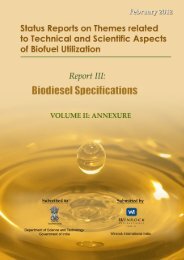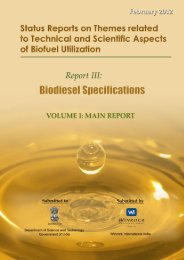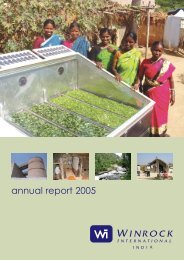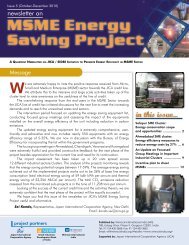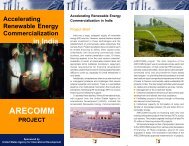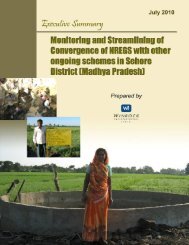IssuE 8 â ApRIl â JuNE 2011 - Winrock International India
IssuE 8 â ApRIl â JuNE 2011 - Winrock International India
IssuE 8 â ApRIl â JuNE 2011 - Winrock International India
Create successful ePaper yourself
Turn your PDF publications into a flip-book with our unique Google optimized e-Paper software.
Bioenergy for Himalayas<br />
problem of storage costs on account<br />
of the fact that it is produced during<br />
day while the demand for household<br />
energy peaks at night. Water flow<br />
based micro-hydel systems offer<br />
good opportunities in many places<br />
but has obvious limitations during<br />
the prolonged dry periods when the<br />
amount of water gets reduced sharply<br />
over most of the Himalayas.<br />
Thus wind, solar, and micro-hydel<br />
stand-alone energy systems all have<br />
seasonal, locational, maintenance<br />
expertise and maintenance cost<br />
limitations that might not permit<br />
high levels of dependence on these<br />
systems in the Himalayas. In contrast,<br />
biomass based energy systems may<br />
prove better option since their primary<br />
requirement is land which is often<br />
available in remote areas at relatively<br />
low opportunity costs. There is<br />
plentiful human expertise available<br />
in remotest parts in tree rearing and<br />
harvesting and most small sized<br />
modern biomass gasification based<br />
electricity generation systems require<br />
a level of routine maintenance that can<br />
be undertaken by most villagers with<br />
only a few hours of training under<br />
minimal supervision by higher levels<br />
of technical expertise.<br />
Objective<br />
Biomass based energy systems,<br />
however, also have a number of<br />
limiting factors, and positive and<br />
negative externalities that are site<br />
specific. Large quantities of sustainable<br />
production of woody biomass would<br />
be required for meeting the growing<br />
demand of energy in these localities<br />
which can not be supplied using<br />
wastelands alone as has often been<br />
proposed in national wood energy<br />
policies and considerable extents<br />
of new lands, not hitherto used for<br />
wood production, would have to<br />
be utilized for this purpose. The<br />
production of woody biomass for<br />
this energy system has a number of<br />
associated externalities, both positive<br />
and negative. Generally, positive<br />
externalities are soil and moisture<br />
conservation on hill slopes, landslide<br />
control and energy security. Food<br />
security, water availability, biodiversity<br />
conservation and conservation of<br />
wildlife can, however, be negatively<br />
impacted by intensive cultivation of<br />
large quantities of woody biomass<br />
for energy production. For a<br />
meaningful economic development<br />
of these hill regions it is imperative<br />
that the positive externalities far<br />
outweigh the negative ones in these<br />
biomassfor- energy production sites.<br />
This paper suggests ways to balance<br />
supporting and limiting factors and<br />
positive and negative externalities for<br />
selecting suitable sites for biomass<br />
energy systems and thus develops a<br />
theoretical basis for optimizing site<br />
selection for stand-alone biomass based<br />
energy systems for remote isolated<br />
communities in the Himalayas.<br />
A Key Element of<br />
Low Carbon Path of<br />
Development<br />
Biomass based modern form of energy<br />
is a key element of the low carbon<br />
path of development that is considered<br />
crucial for limiting the climate change<br />
to a level above which it can have<br />
dangerous consequences for the<br />
earth. In the G20 summit held at Italy<br />
in July 2009 it was decided that all<br />
countries, developed and developing,<br />
take steps to limit the temperature<br />
rise to 2 degree Celsius by the year<br />
2100. Such a step would require an<br />
emission cut as high as 80% below the<br />
1990 levels for the larger developed<br />
economies and similar departures<br />
from the business-as-usual scenarios<br />
for the big developing economies of<br />
Often the single<br />
most important step<br />
in the direction of<br />
poverty alleviation is<br />
a significant increase<br />
in the provision of<br />
both household and<br />
commercial energy to<br />
the poor communities<br />
at affordable prices.<br />
China, <strong>India</strong>, Brazil, Indonesia and<br />
others. Such deep changes can not be<br />
achieved based on energy efficiency<br />
and other technological innovations<br />
while continuing to grow economically<br />
relying on fossil energy. The biomass<br />
based energy, even at its current stage<br />
of technological development, has a<br />
high potential to permit a significant<br />
shift from fossil energy of the past<br />
to the energy that reaches the earth<br />
today and is available to us through<br />
photosynthesis. It is for this reason that<br />
biomass based energy is a key element<br />
in the low carbon path of development<br />
that is so crucial to prevent dangerous<br />
consequences to the earth from the<br />
warming climate.<br />
Understanding Risks<br />
and Uncertainties for<br />
Encouraging Investments<br />
New developments in the energy<br />
sector on a scale large enough to make<br />
a significant contribution to the energy<br />
supply become possible through<br />
the willingness of the investors,<br />
developers and suppliers to enter the<br />
market which is, in turn, dependent<br />
upon the risk and reward environment<br />
of such ventures (Elghali et al, 2007).<br />
To the investors, who can not rely on<br />
ecological benefits for making gains on<br />
their investments except to the extent<br />
April-June <strong>2011</strong><br />
15




